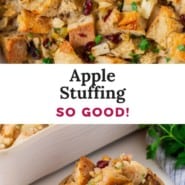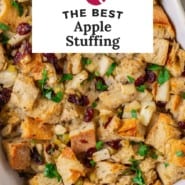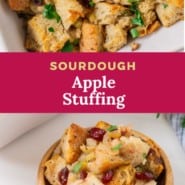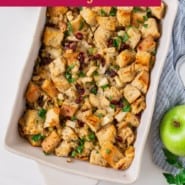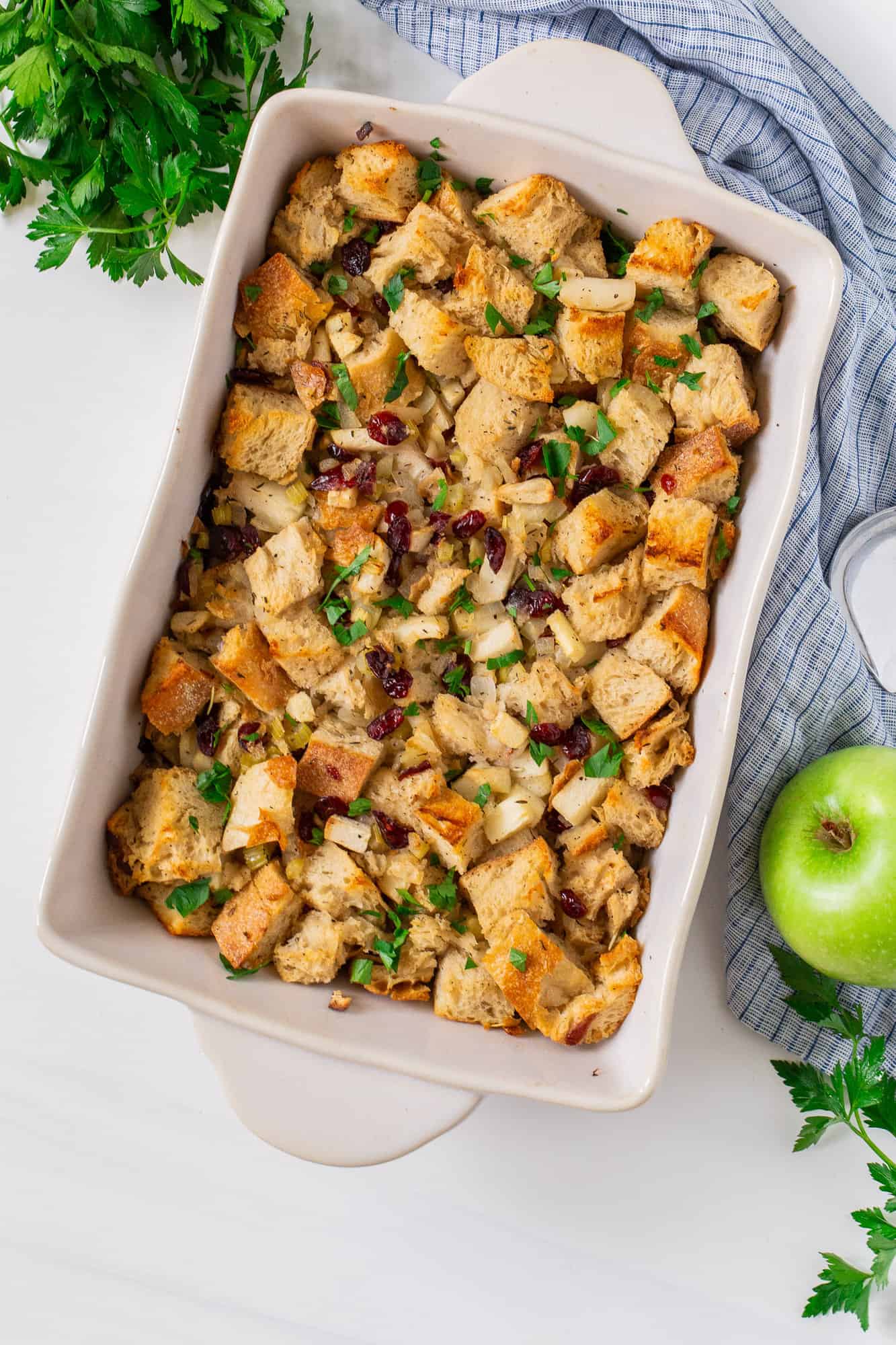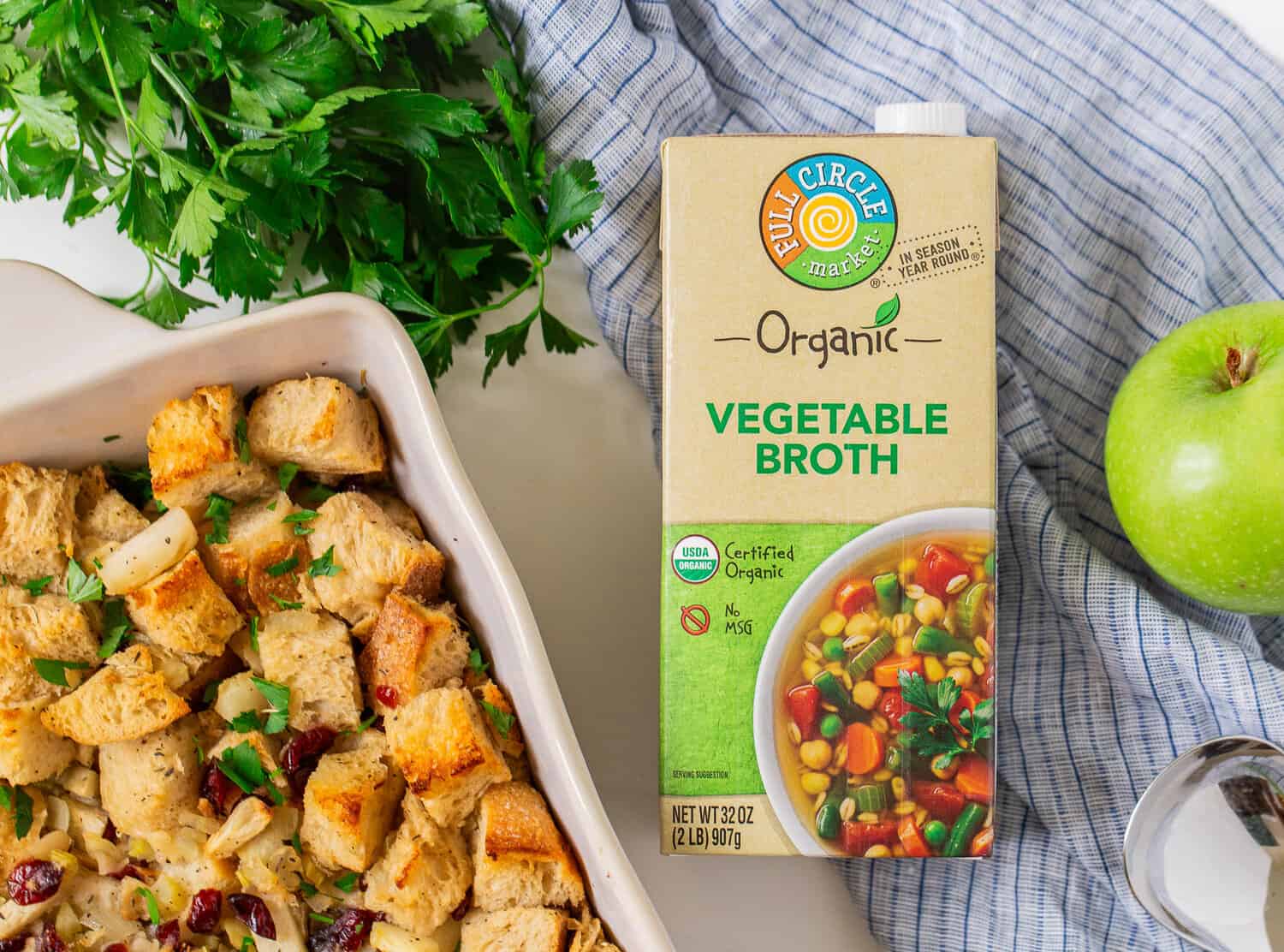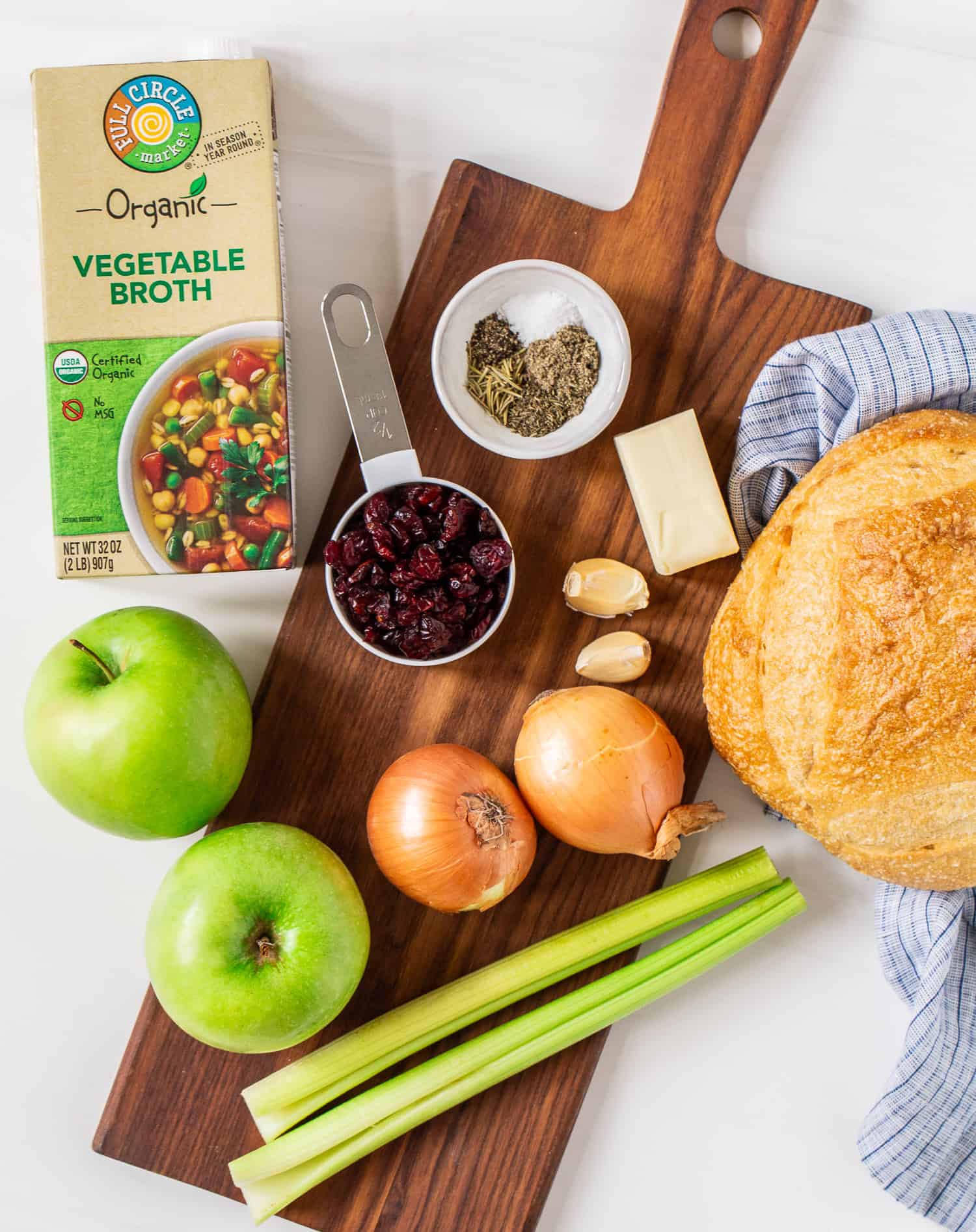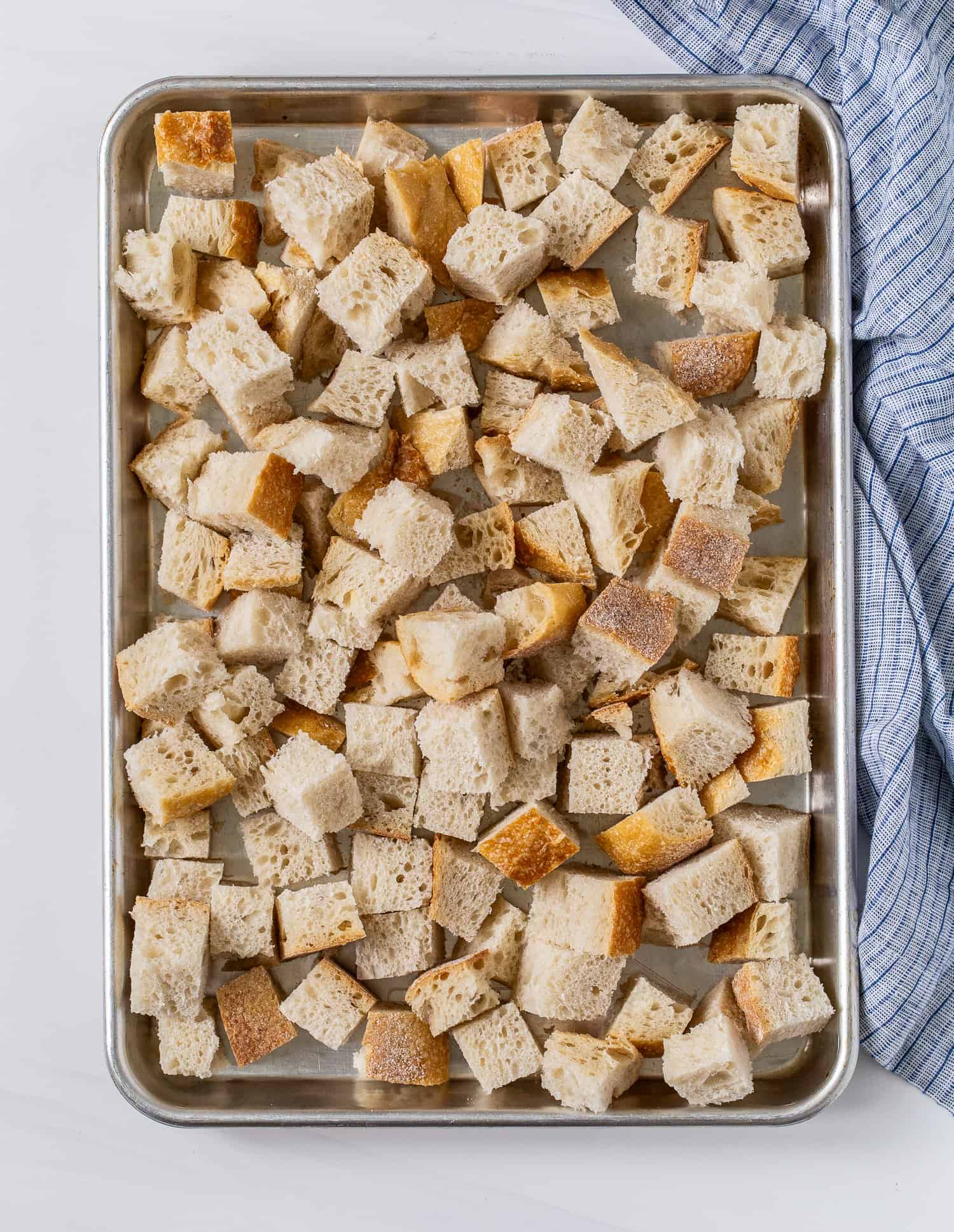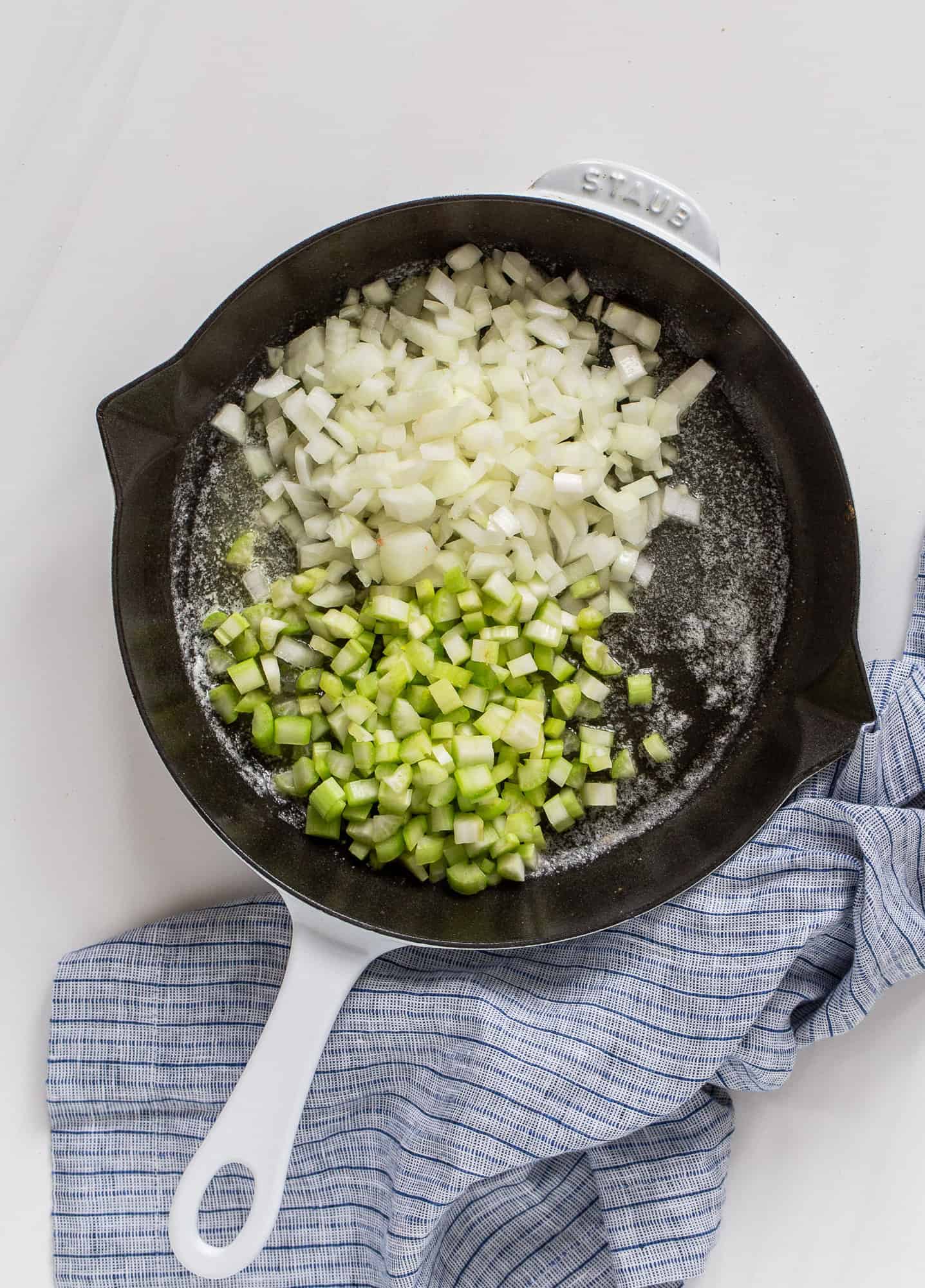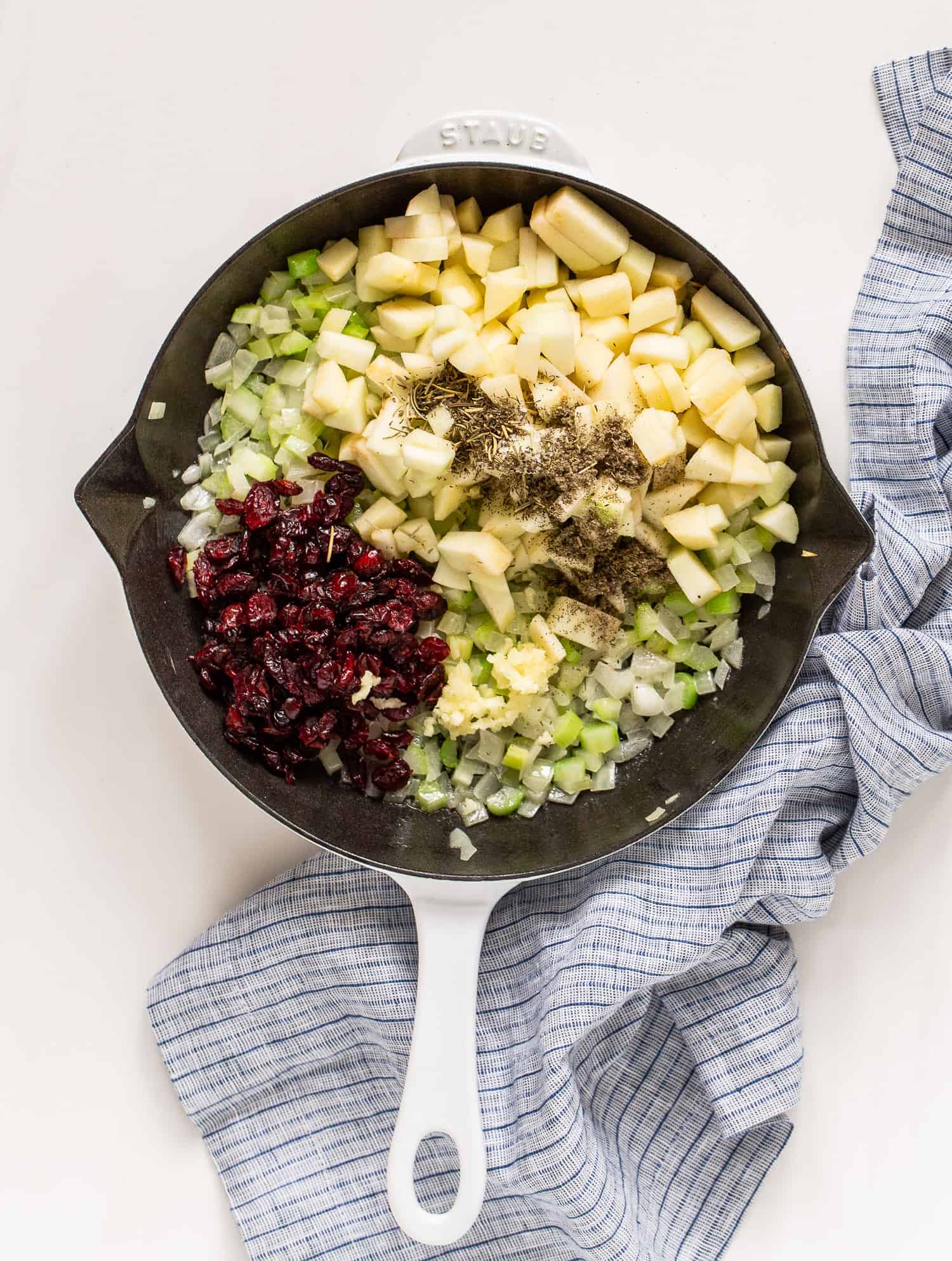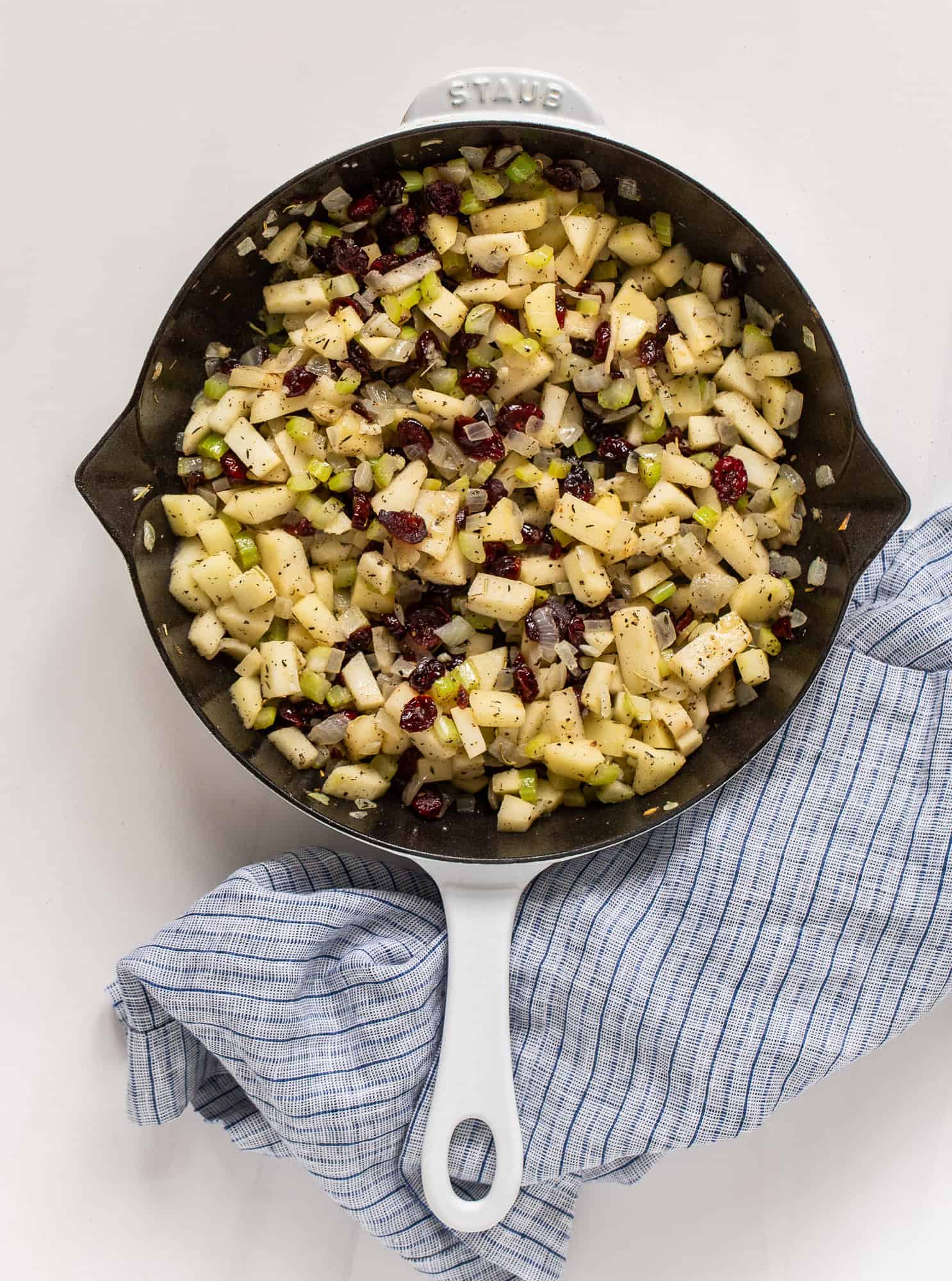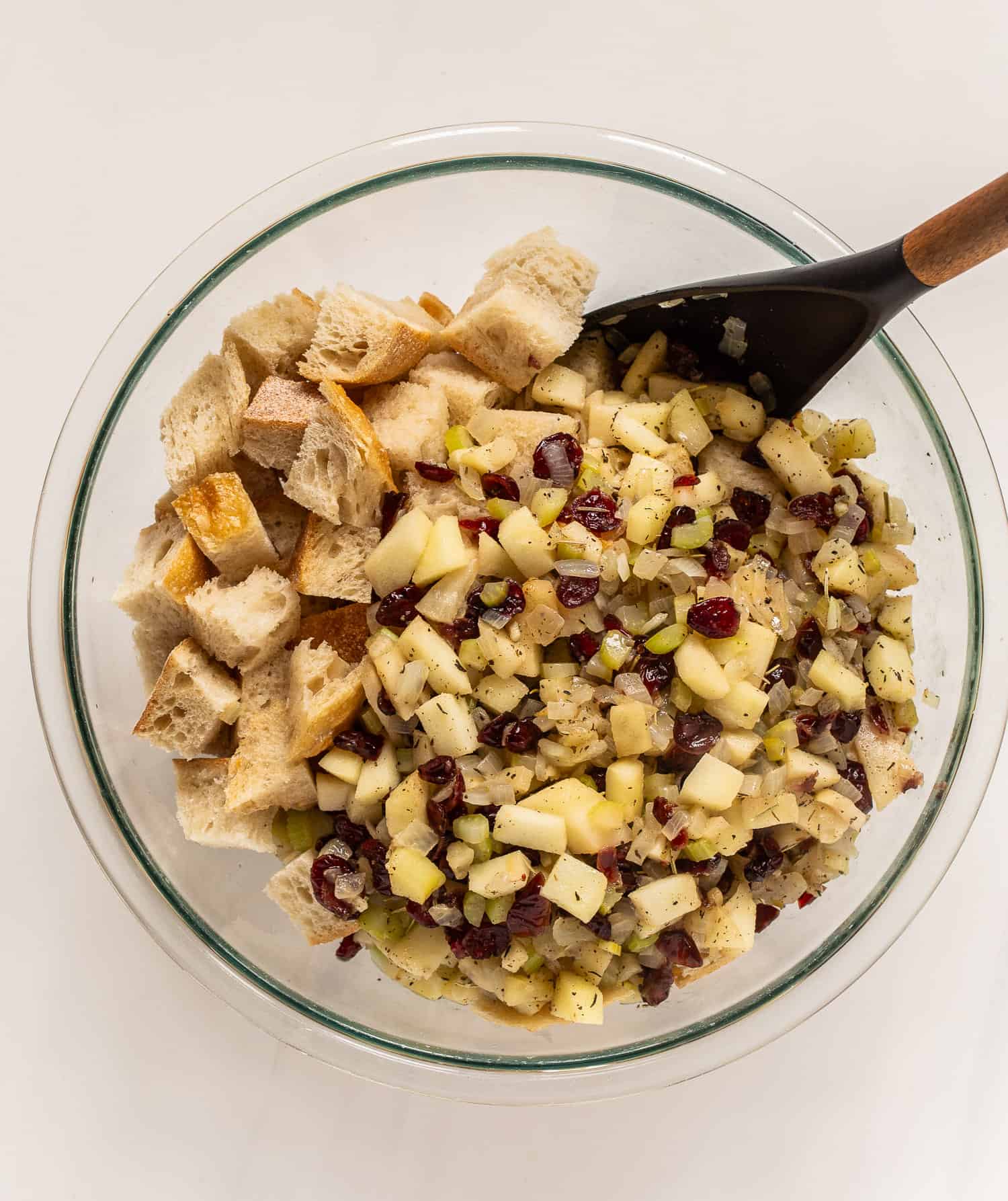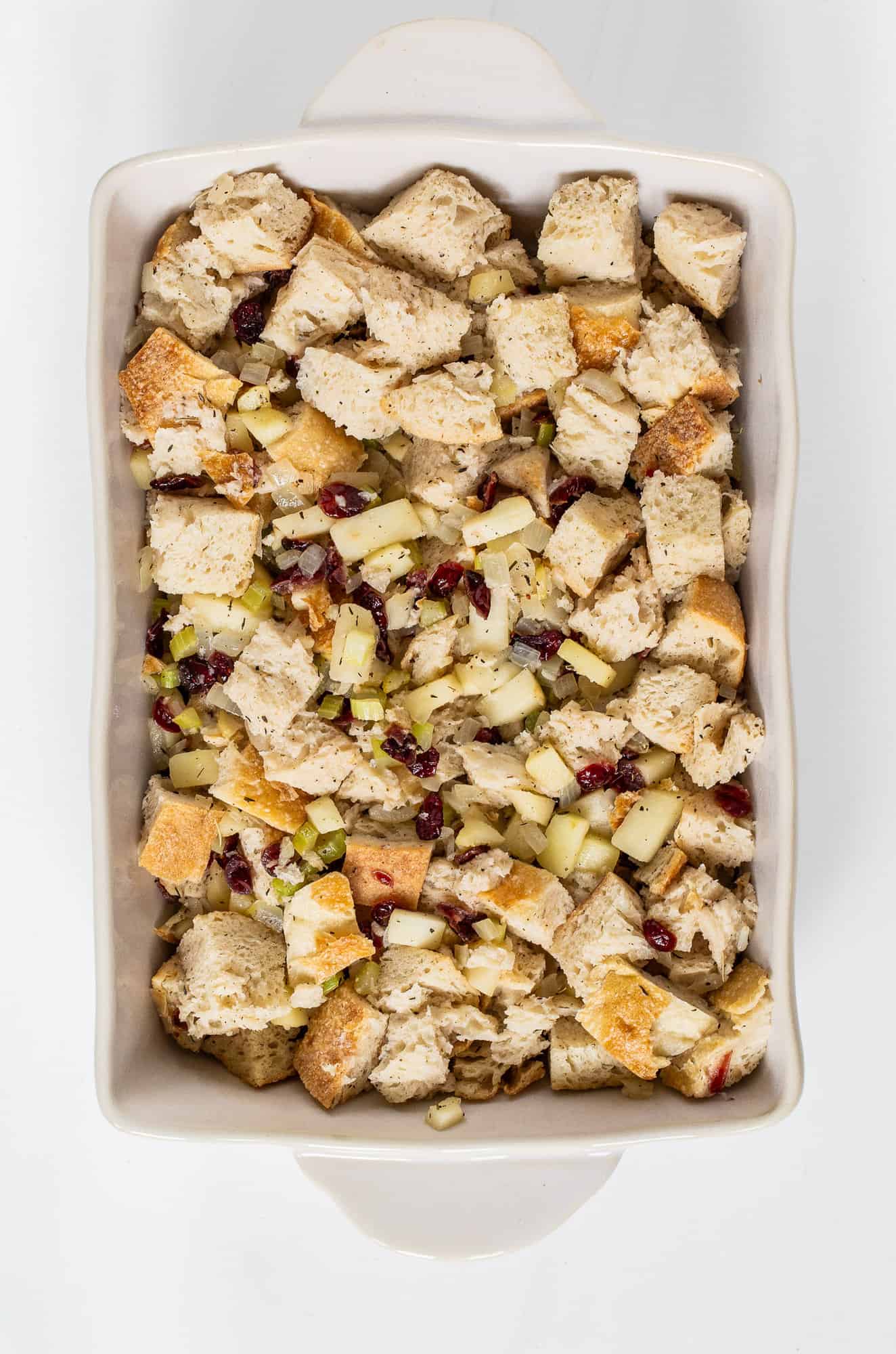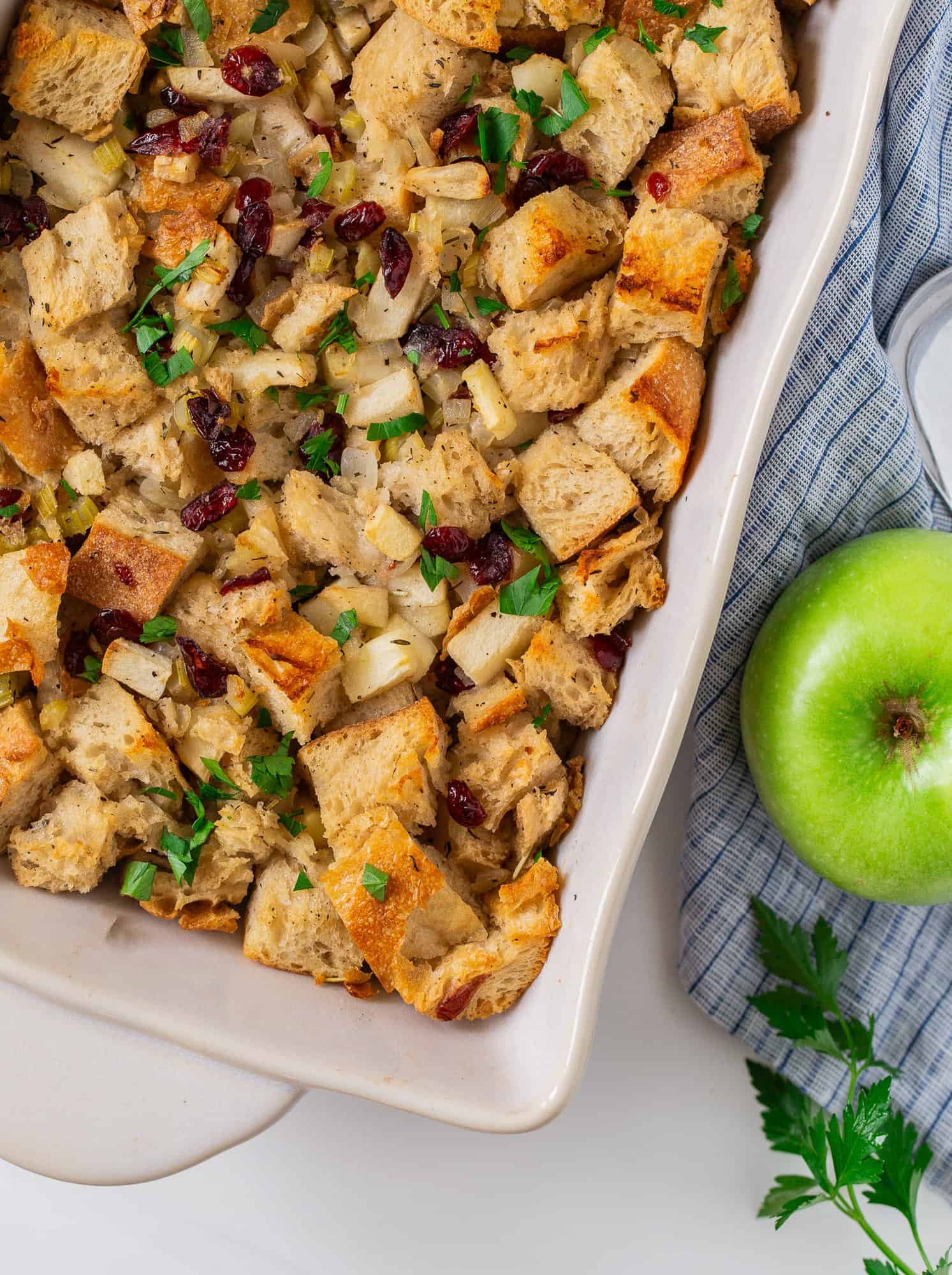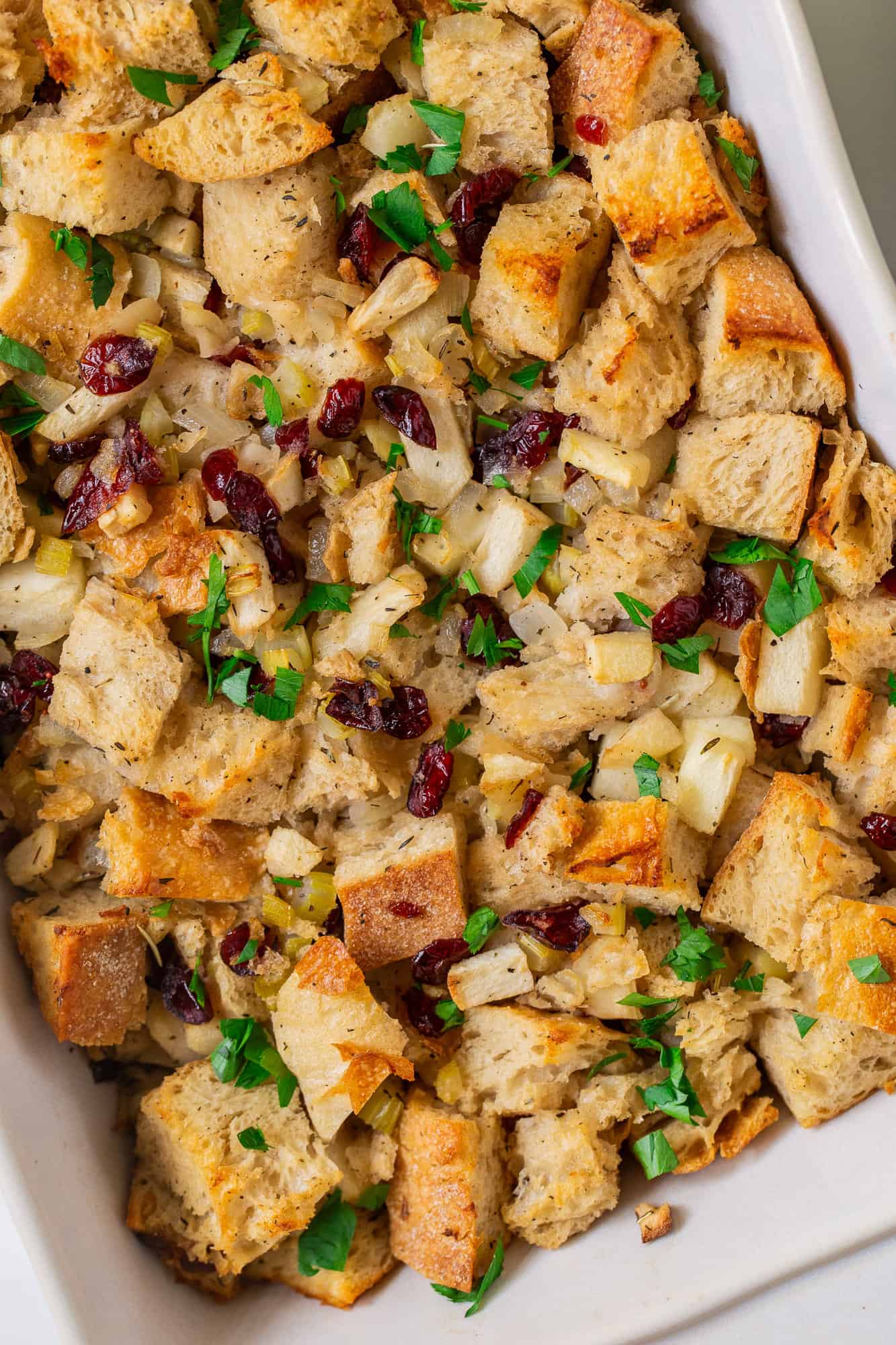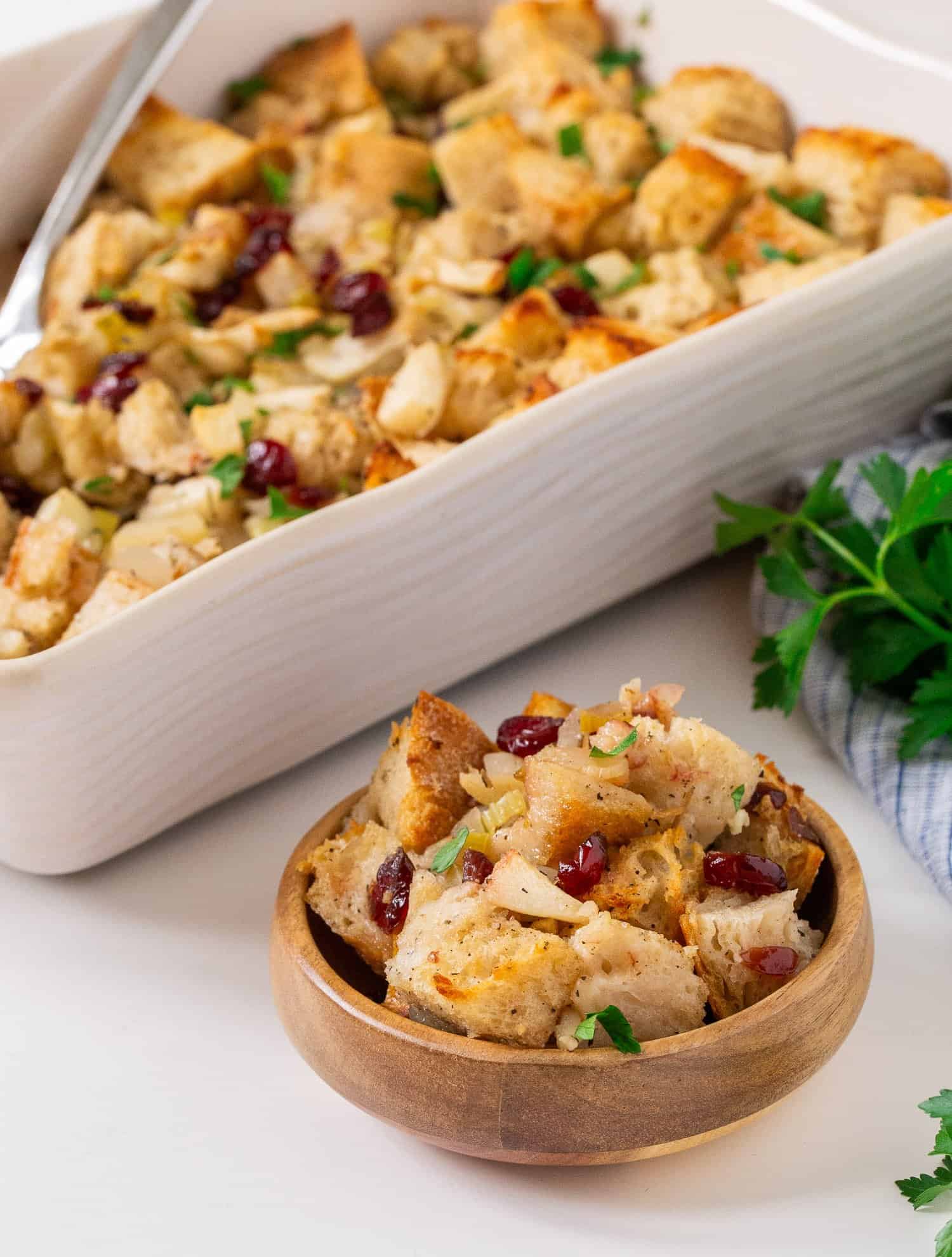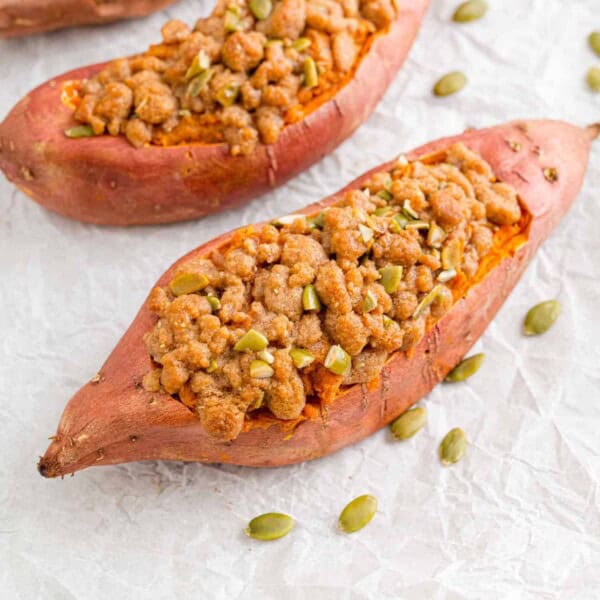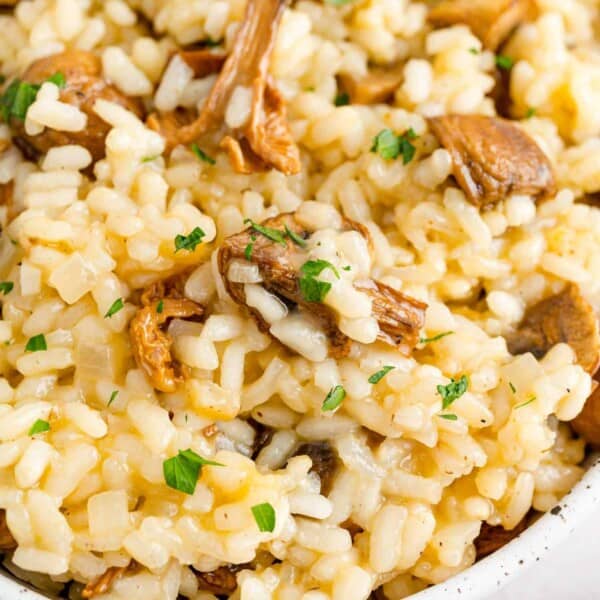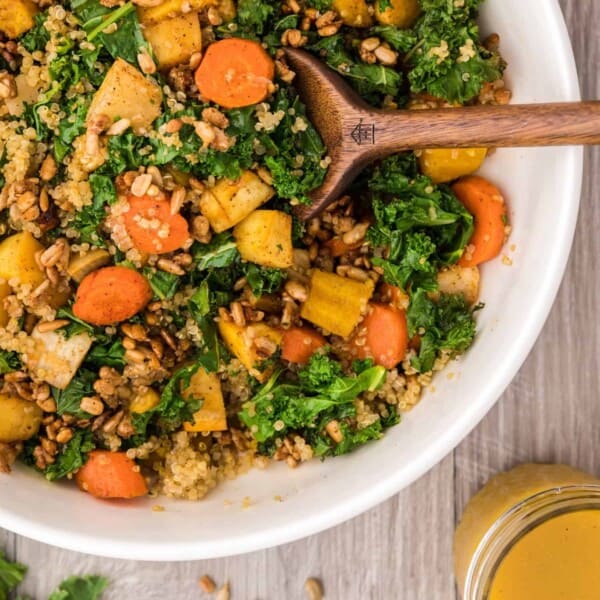This blog post is in partnership with Spartan Nash and Family Fare. All opinions are my own. How long it takes: 15 minutes to prep, about an hour to bake Equipment you’ll need: large skillet, 9 x 13 inch baking dish Servings: 10
About This Apple Stuffing Recipe
When you ask me what my favorite part of Thanksgiving is, my answer is always stuffing. Soft bread full of delicious add-ins and flavorful herbs? Basically a dream come true. I picked up sourdough bread along with all the other ingredients I needed at Family Fare. When you shop at their bakery, produce, meat, and deli departments, you can be confident you’re getting fine and fresh products. And if you don’t, they will give you your money back AND replace the product for free. They have a variety of product lines including Full Circle Market, Our Family, and Fresh and Finest. They have something for everyone and every budget. I used Full Circle Market vegetable broth to make this stuffing completely vegetarian. Not only is it vegetarian, but it’s the perfect blend of savory and sweet, and is a celebration of fall flavors. It’s the perfect side dish on Thanksgiving or any other day (keep reading for ideas!).
Ingredients you’ll need
I’ll describe the ingredients and cooking process here but be sure to refer to the recipe card below for more specific information.
Bread: Look for a large loaf of sourdough bakery bread, unsliced or sliced. We found that the tangy flavor of sourdough bread complements the tart apples and cranberries in this apple stuffing. For the best stuffing, the bread should be somewhat coarse and dry. Butter: Use unsalted butter if you have it (if you don’t, decrease the amount of added salt). You’ll use butter to sauté the vegetables and to add richness to the stuffing. Onions, Celery, Garlic: These aromatics are typically found in stuffing recipes. They add flavor and texture. A yellow cooking onion is best because it has a finer texture but if you have another type of onion, that’s fine. Garlic can be increased or decreased according to taste. Apples: You’ll need a couple of firm tart apples. Choose a variety that holds its shape when cooked, such as Granny Smith, Fuji, Jonathan, or Gala. Peel, core, and chop the apples into small evenly-sized pieces. Dried Cranberries: Choose plain dried cranberries, not the flavor-infused varieties. If they’ve been in your pantry awhile and are very dry, soak them in a bit of hot water for a half hour. Drain well before using. Dried Herbs: A savory medley of dried herbs, sage, thyme, and rosemary, adds just the right flavor to your stuffing. Use dried leaves, not ground herbs. If you prefer, substitute fresh herbs but increase the amount to a generous 1½ teaspoons each. Broth: Choose either chicken or vegetable broth, low or no sodium preferred. Fresh Parsley: An optional garnish of freshly chopped parsley adds a bright note of color and flavor to homemade stuffing.
How to make Apple Stuffing
Prep the bread. Slice the bread; stack three or four slices and cut it into strips. Cut each stack of strips into small cubes, pretty evenly sized, one half to one inch. Alternatively, you can tear the bread into rough chunks if you prefer a more rustic style of stuffing. If the bread is day old and somewhat dry, it’s probably all ready to make into stuffing without drying it further. Fresh bread has more moisture and it’s important to dry it out so that it can soak up the flavorful broth and seasonings. There are two methods you can choose from. Cook the vegetables. Melt the butter in a large skillet. Add the chopped onions and celery; cook them for five minutes or so, until they begin to soften. The onion should be somewhat translucent. (If you opt to add sausage to your stuffing, you can brown it with the onion/celery mixture.) Add the apples, cranberries, and seasonings. Add the chopped apples, dried cranberries, garlic, herbs, and seasonings. Cook, stirring occasionally, just a few minutes. The apples and cranberries will become a bit softer; the garlic and dried herbs will become more fragrant as they hydrate and cook. Combine with bread and add broth. In a very large bowl, combine the dried bread, and the contents of the skillet. Gradually stir in 1½ cups broth, tossing the bread so that the broth is evenly dispersed. You may need to add more broth. The amount of broth you add depends on how dry your bread is and how moist you like your stuffing. I would stick to somewhere between 1 ½ to 2 ½ cups of broth total. Bake the apple stuffing. Spoon the stuffing into a large, greased baking dish. Bake for 45 to 55 minutes or until stuffing is hot and slightly browned. Serve garnished with fresh parsley, if desired.
What To Serve With Apple Stuffing
Stuffing is traditionally served with turkey on Thanksgiving Day but if you love stuffing, why limit it to one day per year? Apple stuffing goes well with a roasted chicken or pork roast (try my Instant Pot pork loin roast). Serve it with a pork chop dinner, spice rubbed pork tenderloin, or easy air fryer pork tenderloin. Try it with grilled pork and apple kebobs. Fill squash halves with apple cranberry stuffing and bake them for a very satisfying vegetarian entrée (see my stuffed butternut squash recipe). Top them with chopped pecans and goat cheese, if you like.
Tips For Success
Use dry bread. Fresh bread has too much moisture but dry bread is like a sponge; it soaks up lots of broth without becoming sticky or gummy, and it has more structure.
Choose the right kind of apple. Some apples become very soft when baked, such as McIntosh or Golden Delicious. They’re great for applesauce but not so great for stuffing. I’ve found that the best apples to use for this stuffing are Granny Smith apples because they are firm and tart. Other varieties you could choose are Fuji, Jonathan, or Gala. Don’t overbake the stuffing. The stuffing should be moist and very lightly browned. If you like a crisper, more browned top, briefly broil the stuffing, watching closely to make sure it doesn’t burn.
Ways To Change This Apple Stuffing Recipe
Use different bread. Feel free to substitute any type of bread you like for stuffing. It should have good structure and large crumb. Avoid white sandwich bread which can be spongy and soft. Shortcut: Use a bag of dried bread cubes or stuffing mix (such as Pepperidge Farm). If the bag has pre-added herbs, omit the dried herbs in the recipe. Avoid stovetop stuffing mixes. Substitute raisins for the cranberries. Make a half-batch. If you’re not preparing a holiday dinner, ten servings may be way too much stuffing but it’s easy to cut the recipe in half! Add-in ideas: If you’re a fan of meat stuffing, feel free to add your choice of cooked crumbled sausage or bacon to the mix. Toasted pecans or walnuts are delicious, too. If you like the idea of fruit in stuffing, be sure to try my pineapple stuffing, too. It goes really well with Easter ham dinners.
Make Ahead Ideas
Dry the bread ahead of time. Cube or tear the bread into pieces. Let it set out overnight, lightly covered with a towel or paper towels. If you prefer, dry the bread in the oven as directed on the recipe card; let it cool completely before storing it in a bag or container. If the loaf is day-old or somewhat dry already, you can skip the drying/toasting step.
Prep the vegetable/fruit mixture. The onions, celery, garlic, and apple can be prepped ahead of time and refrigerated. Go one step further and cook the mixture as directed. Refrigerate for up to a day. Warm the mixture briefly in the microwave before combining it with the bread to make the apple stuffing.
Storage & Reheating Tips
Uncooked stuffing: According to USDA recommendations, you should never store uncooked stuffing in the refrigerator because it’s an ideal medium for the growth of bacteria; however, uncooked stuffing can be frozen immediately after making it. It will keep for up to three months. To reheat frozen uncooked stuffing: Do not thaw the stuffing before reheating. Bake the frozen uncooked stuffing as directed on the recipe card, adding more time as needed, until the internal temperature reaches at least 165°F. Cooked stuffing: Leftover cooked stuffing can be safely refrigerated for 3 to 4 days, as long as it hasn’t set out at room temperature for more than 2 hours. It can be frozen for up to 3 months. To reheat cooked stuffing: Place stuffing in a baking dish; cover with foil. Place in a preheated 350ºF oven; bake until heated through, 20 to 30 minutes (longer if frozen). Smaller portions can be reheated in the microwave.
This content and recipe is in partnership with Spartan Nash and Family Fare. I was compensated for my time but all opinions are, as always, my own. Thank you for supporting Rachel Cooks by reading about brands we use and love in our own home. Sponsored posts like these help me cover some of the expenses involved with keeping this site free for you to use! Quick-Start Guide!
